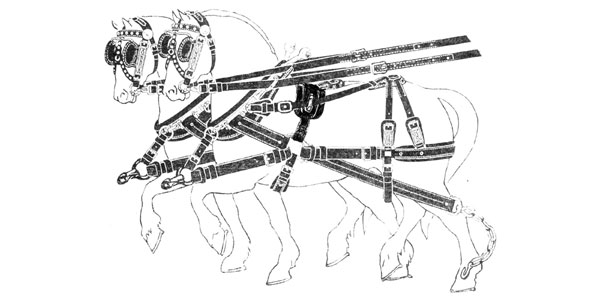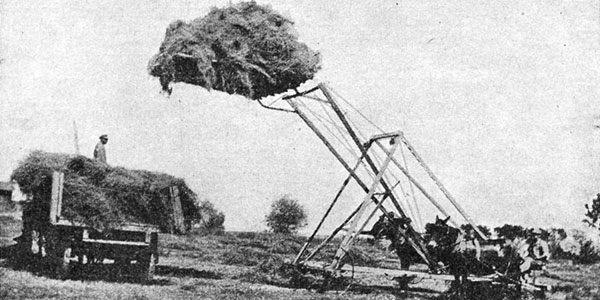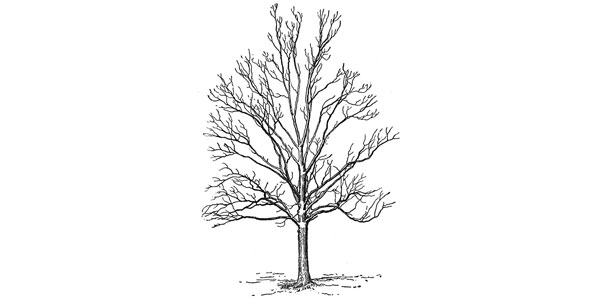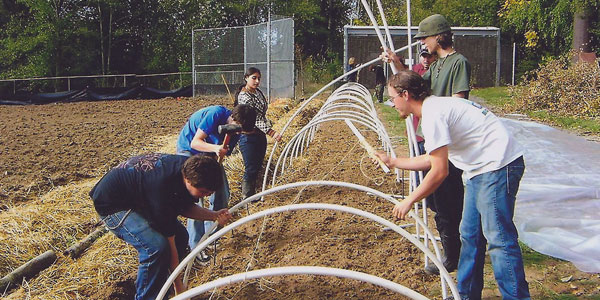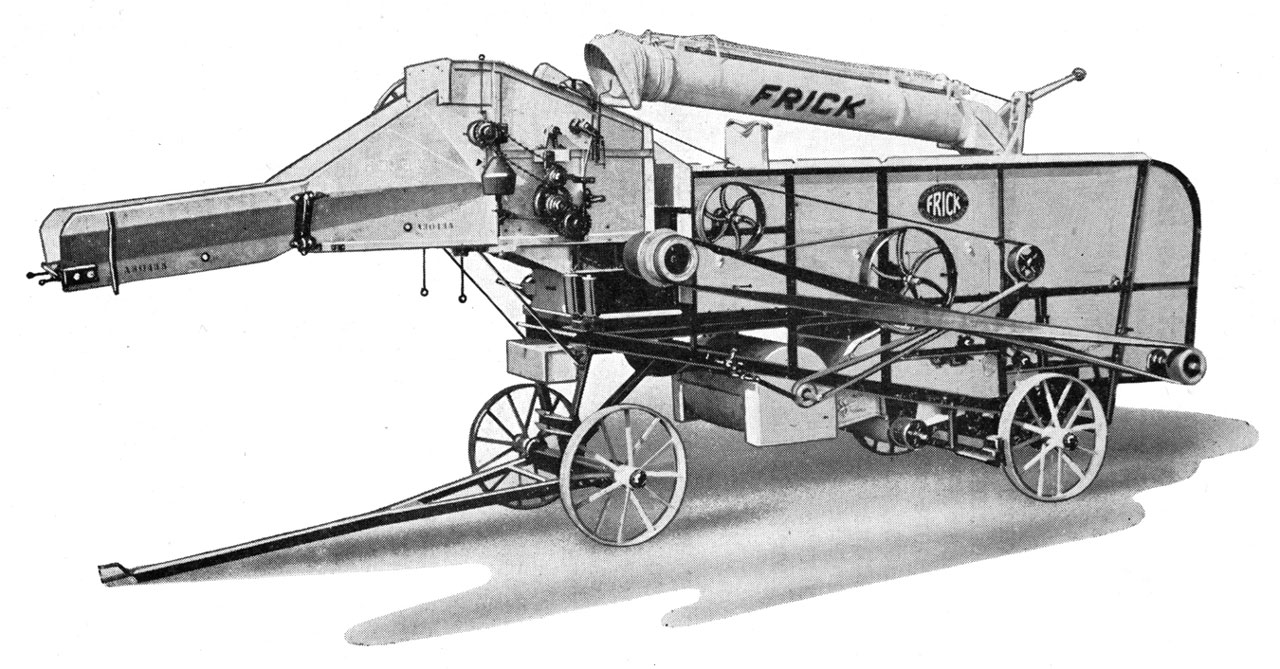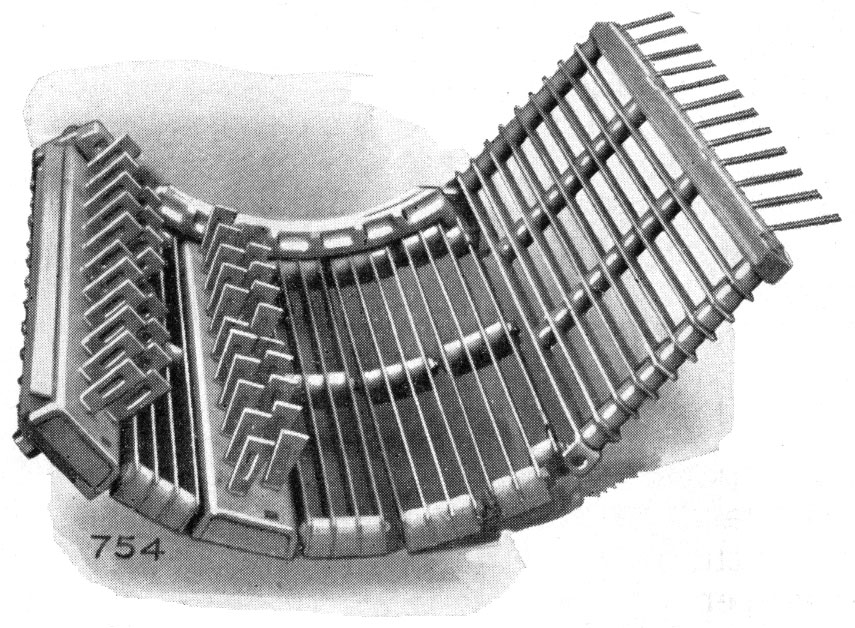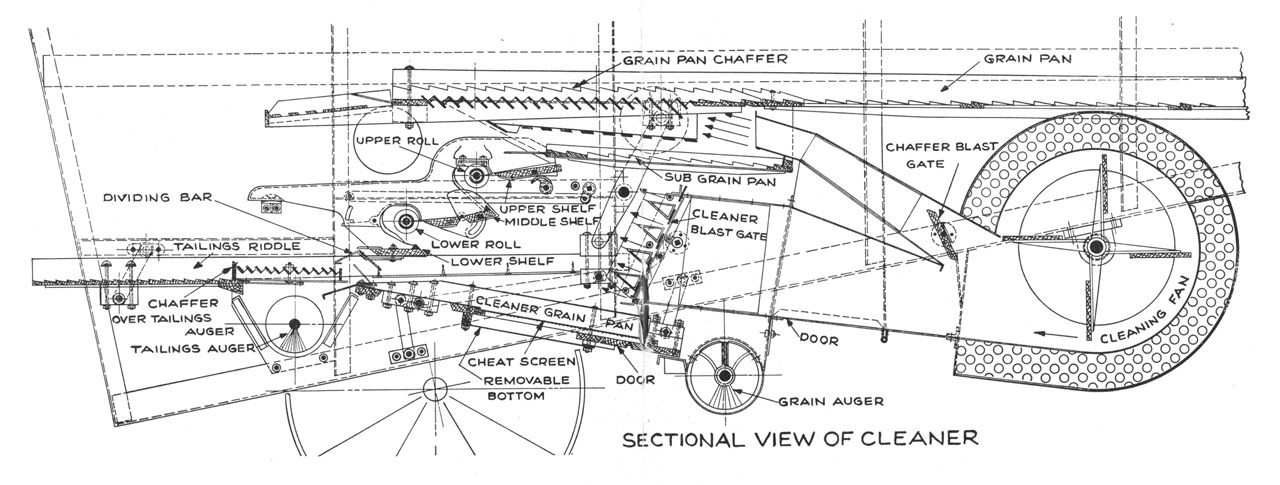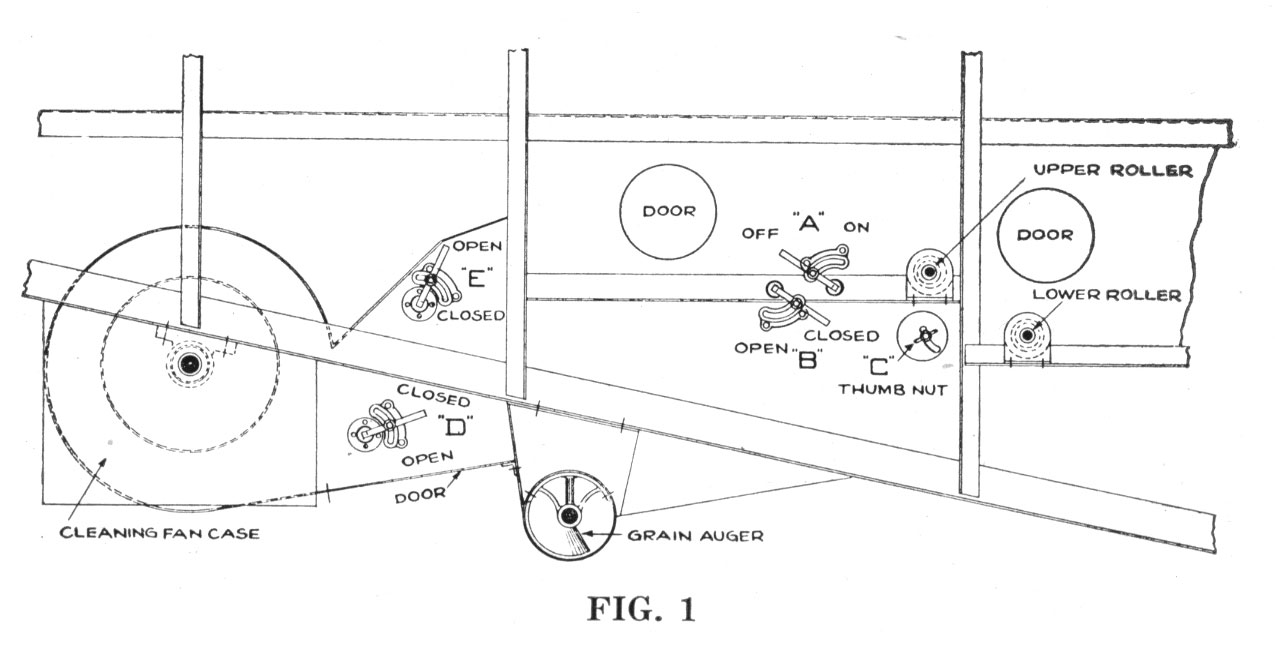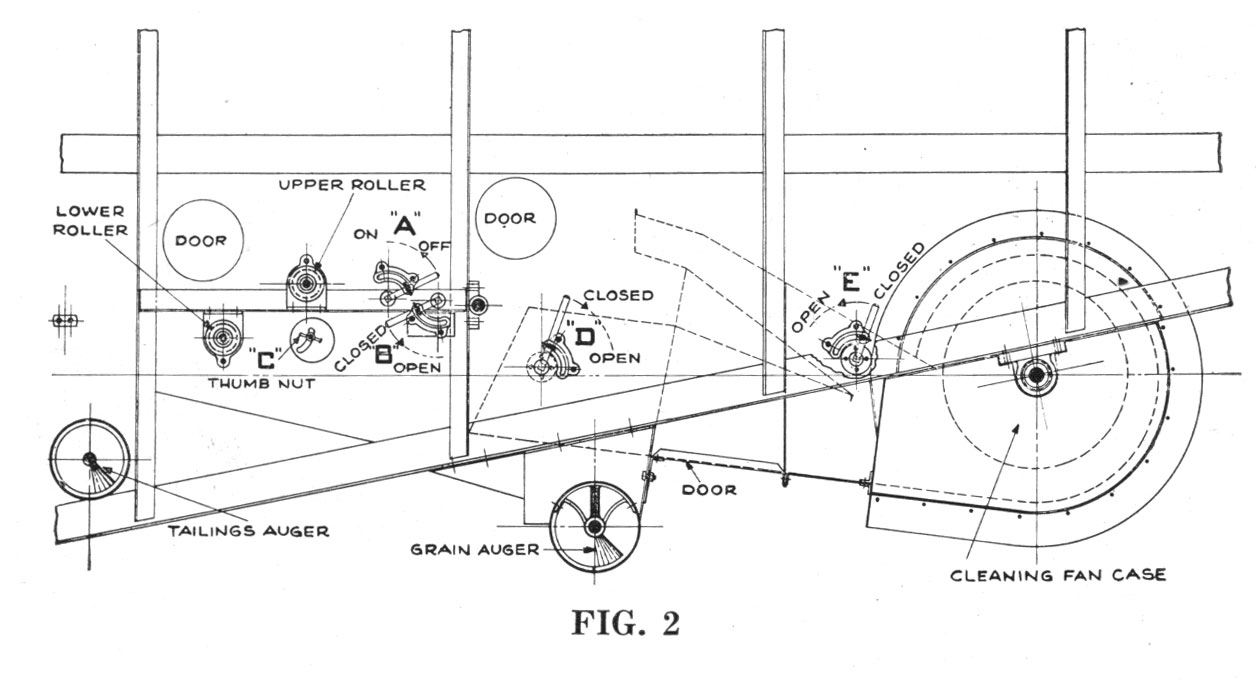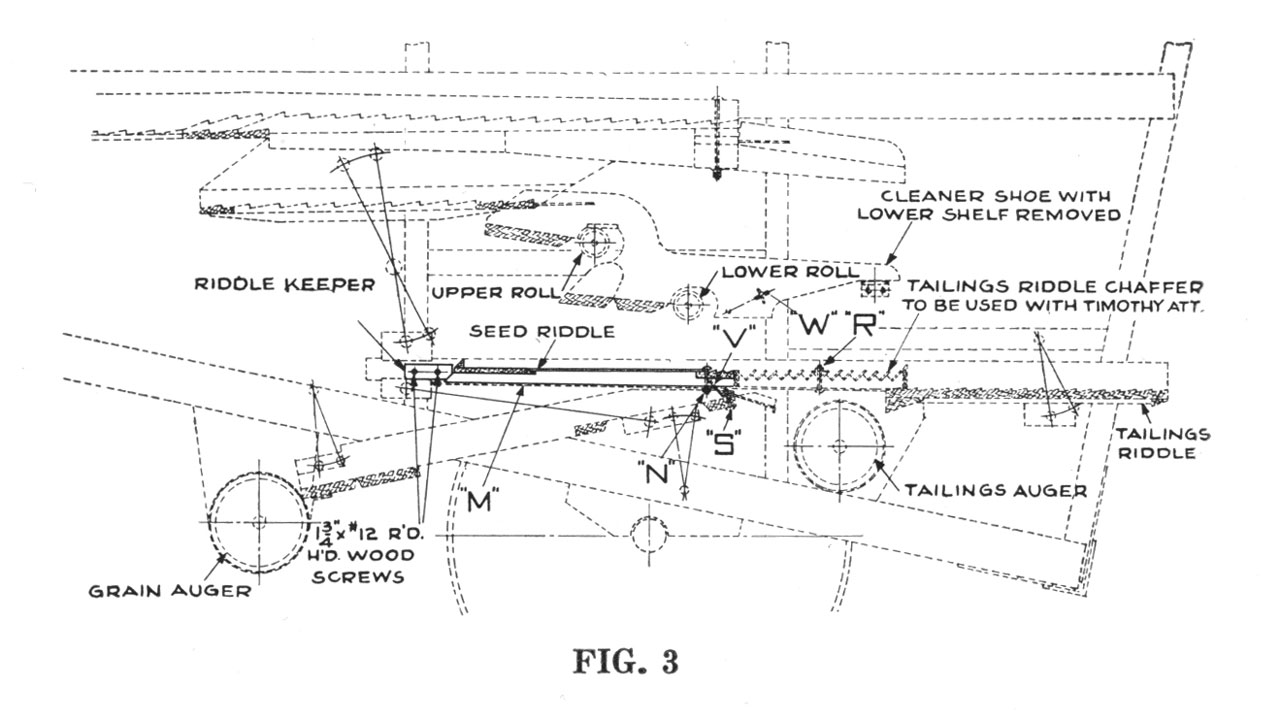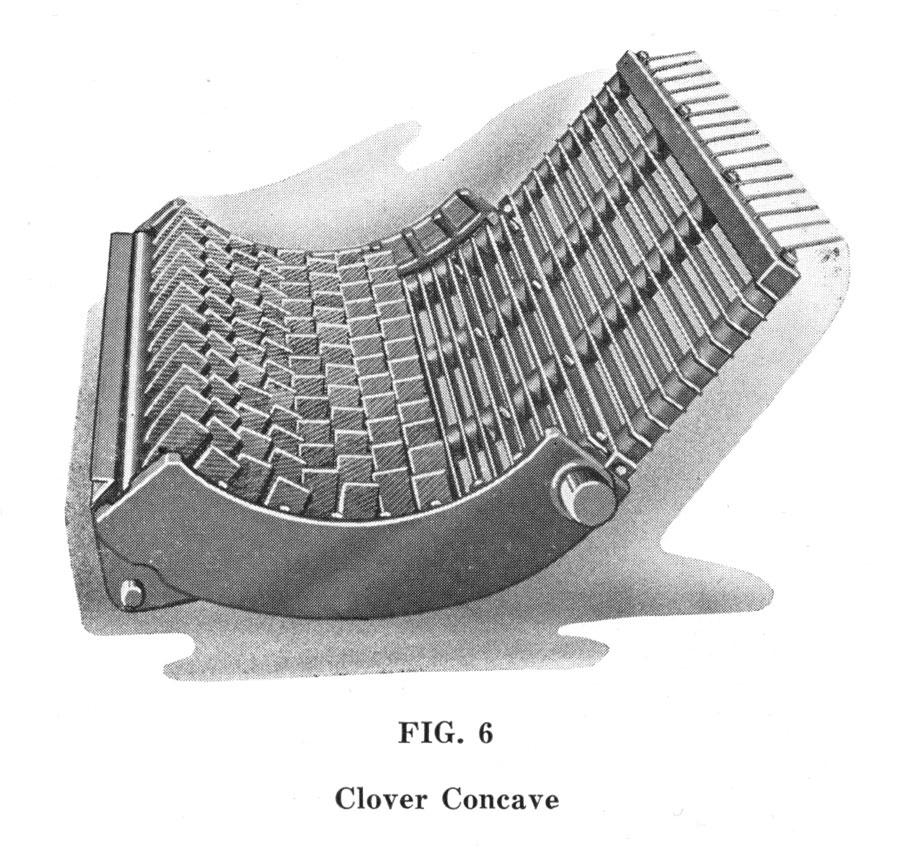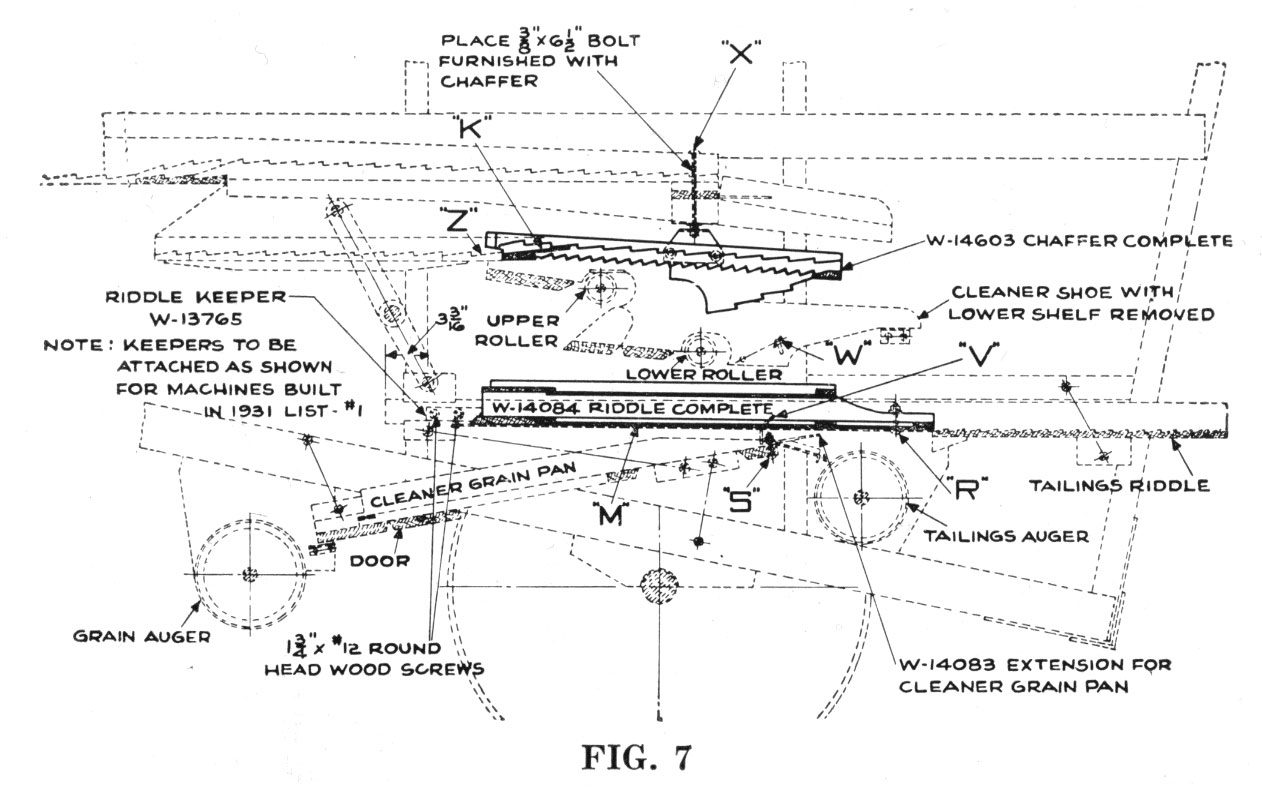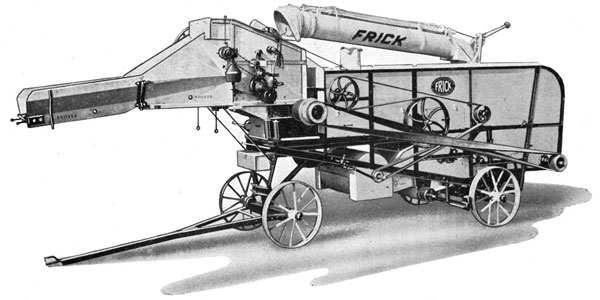
Frick Steel Thresher
Directions for Operating and Adjusting the
Frick Steel Thresher
Editor’s Note: We have not had occasion to watch this particular make of thresher in operation, in fact we haven’t seen one other than in pictures. This little pamphlet (circa 1920) offered up some very good operational diagrams and information that should apply to most threshing machines. Hope you find this useful. – LRM
The thresherman purchasing a new machine should at once familiarize himself with its general construction. He should examine every piece or part about it; learn its name, and the functions each has to perform. We especially request and insist, as a matter of first importance, that you carefully examine the machine as soon as you receive it to see if anything has been misplaced, broken or lost. Clean all parts until free of dust and grit that may have accumulated during transportation.
Start Right
Thoroughly post yourself on the directions given to operate the machine, as much depends upon a good start. Sometimes prejudice and an unjust opinion has been formed against a good machine due to a bad start. It is to the interest of every thresherman who purchases a “Frick” to become perfectly familiar with every working part of it. Then on starting watch every movement of the working parts and see that everything is properly adjusted, so that it runs smoothly. Never attempt to test out a new machine on capacity and speed for two or three days, or until you fully understand it. Nothing is gained by crowding and undue haste. Every thresherman who will exercise ordinary care and pay attention to his business can make a success of threshing with the Frick machine.
Leveling, Oiling, Belting
On starting, see that the machine is set level, lengthwise as well as crosswise. Be sure that all bearings have been well greased. See that the machine has been properly belted and that every working part is moving. Examine carefully the various bolts and nuts; be sure they are all tight.
Speed
Speed up gradually to threshing speed. The straw rack crank speed should be 230 revolutions for dry grains and about 240 revolutions when the grain is damp, or hard to thresh. After starting to thresh, the speed should be taken again to see that the machine is running as above indicated. The operating parts should not vary more than 10 revolutions above or below that recommended to properly clean the grain and avoid throwing grain out with the straw.
Study the Conditions
Before starting to feed the machine, examine the grain carefully as to its condition, and the kind of filth you will have to contend with. Such knowledge will better assist you in making a good start, and doing good work from the beginning.
It is of the utmost importance to have sufficient dependable power, delivered at regular speed, for operating the machine at its capacity, or at the rate you propose to thresh and where you have set your adjustments. Dry grain and slow threshing requires less power than fast threshing and damp grain. You cannot and should not expect to do good work with a shortage of power or slow speed.
Drive Belt and Cylinder Pulley
Another important detail is the main drive belt; never attempt to operate the machine with a poor belt. The weight and width of the belt should be such as to satisfactorily deliver the power available. It is very important that the cylinder pulley be the correct diameter to operate the machine at proper speed when the engine is running at normal speed. A pulley too small in diameter will run the thresher too fast; if too large it will slow the machine down too much. For this reason the operator should see that the proper pulley is provided for the engine being used. To do good work and reflect credit upon himself and the machine, every thresherman should study and have a clear understanding of the above suggestions, which should be closely followed.
Adjustments of Concaves
The concaves should be adjusted to bring the cylinder teeth midway in the space between the concave teeth. This can readily be done by means of three adjusting screws on each side of the thresher below the cylinder bearing. Never attempt to thresh unless the cylinder teeth are centered between the concave teeth. Operate the machine with as few concave teeth as possible, but with enough to do clean threshing. One concave, with enough to do clean threshing. One concave, with two rows of teeth well up to the cylinder, is far better than two concaves with both rows of teeth away from the cylinder. When the concaves are well down, too many heads will pass unthreshed through the space between the ends of cylinder teeth and the concave.
The Work of the Concave Teeth
The duty of the concave teeth is to hold, or retard, the straw until the cylinder teeth have had sufficient time to knock or whip out the grain. Remember that the cylinder teeth do the threshing; the concave teeth simply retain the straw while the threshing process is going on. It is highly important that every thresherman should understand this and see to it that the cylinder is run at the proper speed, with the correct number of concaves, and that the concaves are well up to the cylinder. This will insure clean threshing, and furthermore, will greatly assist in good separation. The operator must use good judgment in this, as he has to be governed almost entirely by the kind, condition, and quality of grain to be threshed.
Cracking Grain
There is nothing that will cause the thresherman or his customers more trouble than the cracking of grain.
Causes of Cracking the Grain
- Cylinder and concave teeth not properly centered. Sprung or bent teeth in cylinder or concave, or in both.
- Operating machine at too high a speed.
- Irregular feeding of very dry grain.
- Concaves too close to cylinder, when threshing dry grain.
- Returning too much grain through the tailings elevator.
In some kinds of wheat, the kernels are very tender or brittle and are easily broken. This condition occurs more frequently in wheat having large kernels than in that with small kernels.
Heating of Bearings
The most important bearings on the Frick Threshers are of the roller or ball type, these being used on the journals of cylinder, wind stacker, cleaning fan, straw rack crank, upper elevator, beater, and the two belt tightner pulleys.
Practically all bearings are equipped with Alemite connections for greasing. It is important that all friction bearing be greased at least twice daily. The roller and ball bearings can be run from one to several days with a single greasing. Wind stacker, cleaning fan and crank bearings were greased and sealed when bearings were manufactured. No further greasing is necessary. Over-greasing is a waste of material, while of course, not enough grease would cause the bearings to heat. Filling the cases of the roller bearings full of grease is not an advantage, as the excess grease works out around the shaft; a small quantity will do the work and cause no waste. The Hyatt bearings used on the beater and ball bearings used on crank and fan shafts are not adjustable. The Shafer bearings used on the cylinder shaft are adjustable. A small lock screw is used to prevent the end adjusting collar from screwing out or in. should this screw become loose, these bearings might get out of adjustment; otherwise, no attention other than oiling should be required. The adjusting collar is provided with threads to take up the end play and should be screwed out if the bearing is too tight and runs hot. Be sure to tighten the small screw after making any adjustment.
Clean Threshing Means Better Separation
Every thresherman purchasing a new machine wants to do just a little better work than his neighbor. It is therefore important that he should operate his machine properly in every particular. He should make every adjustment necessary to do good work. The cylinder should be run at the proper speed and the concaves adjusted to meet the existing conditions and kind of grain, so that all the heads will be threshed clean of every kernel. Otherwise, it will be impossible to get good separation from the straw, because many of the heads that have been only partly threshed by the cylinder will be beaten out while the straw is passing under the deflector beater, causing it to throw the kernels back over the straw. These flying and bounding kernels then settle on top of the mass of straw and chaff as it travels over the straw racks so that when the straw is delivered from the machine this grain which was not knocked out at the cylinder will pass out with the straw and make it appear that the machine has poor separation. The more perfect the threshing, at the cylinder, the nearer the approach to perfect separation.
The Cleaner
The cleaner used in the Frick Steel Thresher is known as the “gravity cleaner,” and is composed of three shelves and two rollers. The shelves are known as the upper, middle, and lower. When assembled, the shelves are called the cleaner “shoe.”
The operating levers for adjusting the blast required to clean the different kinds of grain are placed on the right hand side of the 22×36 machine at “D” and “E.” see illustration Fig. 1. Lever at “D” operates the blast gate to the cleaner and should be adjusted to lift the chaff and filth from the grain as it is passing over the cleaner rolls and shelves. By removing the round door on the side of machine at the cleaner shoe, it will be possible to inspect the amount of blast used, by putting your hand through the door and catching a hand full of chaff and filth just back of the lower shelf tooth comb and metal division cross bar. Should you find grain being blown over in to the tailings riddle chaffer the blast should be reduced by moving lever at “D” up, reducing the amount of blast. The lever at “E” operates the blast gate to the chaffer in rear of grain pan, and should be adjusted to assist as much as possible in separating the chaff and short straw from the grain to relieve the cleaner, and at the same time keep from wasting grain over the rear end of chaffer. For inspecting the work at the chaffer use the round hole at cleaner shoe, catch a handful of chaff and straw, and if you find grain coming over a this point the blast should be reduced by moving lever at “E” towards closed position.
Letters “D” and “E” are on the left hand side of the 28 and 47 machine. See illustration Fig. 2. The instructions for operating cleaner is the same as for the 22 by 36 machine.
To Clean Wheat or Rye
Set the cleaner shoe by moving lever “B” so that there will be an opening of about one eighth of an inch between the lower roller and comb. Open the shutter plate at “C” and set thumb nut about half an inch from the top of the slot; then fasten securely. Regulate the cleaner shoe blast gate lever at “D” to clean the grain. Regulate the blast gate at “E” so as not to blow grain over rear end of chaffer on the tailings riddle.
If the cleaner is not cleaning the grain, it will be necessary to move some of the regulating levers to meet conditions. Referring to Fig. 1 or 2, first put more blast on cleaner by moving lever at “D” down; second, set combs slightly closer to roller by moving lever at “B.” Third, if too much grain is going up the tailings elevator, lower the front end of middle shelf by moving thumb nut at “C,” down.
The cleaner shoe shelves ought always to be filled with a ridge-shaped pile of grain when cleaner is working properly.
If the grain is wet, use a little “knock” on the cleaner shoe by pulling lever “A” toward the “on” position, just enough to keep the grain from loading the cleaner shoe shelves. Do not use any more knock than is necessary.
One double-row concave should be used for threshing rye, and two double-row concaves for wheat.
To Clean Oats
Set the cleaner shoe at lever “B” so that it will have about three-fourths of an inch distance between the lower roller and the comb. Lower the front end of the middle shelf by moving thumb nut at “C” down as far as it will go; pull lever “A” toward the “on” position so that it will have about half the possible knock on the shoe; set wind board lever at “D” so as not to blow the oats over in the tailings riddle. Pull lever “E” towards the “closed” position to reduce the blast over the chaffer. The crank speed should be 230 r.p.m.
To clean barley, close the space between the rollers and comb to half an inch, and use a little more blast than for oats. To beard barley, close the space a little more between rollers and combs to catch the unbearded barley. Move the tailings riddle chaffer away from the dividing bar as far as possible to allow an opening for the unbearded barley to drop into the tailings auger. This will allow them to be returned to the threshing cylinder again to be rethreshed. The crank speed should be 230 r.p.m.
To Thresh and Clean Buckwheat
The thresher cylinder should be run at 800 revolutions per minute, and the straw rack crankshaft should be run at its normal speed of 230 and 240 revolutions. We furnish pulleys of the proper diameter to drive the cleaning fan and the wind stacker (when wind stacker is attached) the main drive pulley should be of a diameter to suit the power being used.
After removing all toothed concaves, replace with the open concaves and fill the balance of the space in the bearers with wood blanks, allowing room for one concave next to feed plate. Adjust the cleaner the same as for wheat.
Timothy, Lespedeza, Alfalfa and Flax Seeds
In threshing any of the above grains the same changes are required, as follows:
To apply the seed riddle, remove the tailings riddle chaffer over the tailings auger by taking off the nuts and washers marked “R: and lifting the chaffer up and out. (Refer to Fig. 3)
Remove the lower cleaner shelf by loosening the twc thumb nuts marked “W” and lifting them to the high position and fasten so that the lower cleaner shelf may be pulled back and out. (This shelf is not used while threshing these seeds.)
Remove the sheet iron crosspiece held in place by the nuts and washers “S” replace with deflector “V” furnished with attachment and secure with nuts and washers “S.”
Slide seed riddle in between rails of tailings riddle on sheet iron rests marked “M” and secure with bolts marked “N” which pass through riddle, and fasten nuts underneath rests marked “M,” as shown; place tailings riddle chaffer in former position as shown, and secure with nuts and washers marked “R.” Adjust the combs close to the rolls and regulate the blast to suit. Operate the machine at about the same speed as in threshing wheat.
The following sizes of screens are required:
| Timothy seed | 1/16” perforated screen |
| Lespedeza seed | 1/8” perforated screen |
| Alfalfa seed | 7/64” perforated screen |
| Flax seed | 5/32” perforated screen |
To Hull Clover Seed
To apply the riddle, remove the riddle chaffer over the tailing auger by removing nuts and washers marked “R” and lifting the chaffer up and out.
Remove the lower cleaner shelf by loosening the two thumb screws marked “W” and lifting them to the high position and fastening, which lifts the latches so that the lower shelf may be pulled back and out. This shelf is not used while hulling seeds.
Remove the sheet iron cross pieces held in place by the nuts and washers marked “S”. Replace the cross piece with the deflector marked “V” which is furnished with the attachment, and secure with nuts and washers marked “S.”
Slide lower riddle in between the rails of the tailings riddle on sheet iron rests marked “M” and secure with bolts marked “N” which pass through riddle, they fasten with nuts underneath the rests as shown.
Attach the riddle keepers on each side (if not on the machine) by means of the round head wood screws furnished. Keepers must fit against end of riddle side rails, as shown.
Put upper riddle in place with projections of side rails resting on end of bottom marked “Z” and with the crosspiece beneath wire fingers marked “K”, bolts marked “X” by removing one nut on each bolt. Place tailings riddle chaffer back into position, and move back to rear as far as it will go, and secure with nuts and washers marked “R”. Remove all the wheat concaves and all the open concaves except the one in the rear of concave bearers. Then put in the four two-row concaves with teeth corrugated
Note: One concave carries the feed plate rest; this one is used in front to support the feed plate. Set the concaves as close as possible to the cylinder.
To Thresh Orchard
To apply the double riddle, remove the tailings riddle chaffer over the tailings auger by taking off the nuts and washers marked “R” and lifting chaffer up and out.
Remove the lower cleaner shelf by loosening the two thumb nuts marked “W” when lifting them to the high position and fastening; this operation lifts the latches so that the lower shelf may be pulled back and out. This shelf is not used while threshing seeds.
Remove the sheet iron cross piece marked “V” by removing the three nuts on the bolts marked “S.” Slide the double screen in between the rails of the tailings riddle on the sheet iron rests marked “M,” and fasten with bolts marked “R,” using the two 5-16” pressed washers furnished with the double screen.
Put chaffer in place with the projections of the side rails resting on the end of bottom marked “Z” and with the cross piece beneath the wire fingers marked “K”, secure with bolts marked “X” by removing one nut on each bolt.
The cleaner shoe should be set the same as for cleaning oats. Close off all the blast from the cleaning fan and operate the machine at the same speed, as for threshing oats.
Pea and Bean Attachment
We furnish special instructions with each attachment for attaching and operating it.
To Thresh and Clean Kaffir Corn
Operate the machine at as slow a speed as possible; that is, the separator should be run at just enough speed to carry the filth over the strawracks. Use only one concave, and that well down, or perhaps better still, use two concaves, with only one row of teeth in each. The cleaner should be set about the same as for wheat, except use plenty of blast.
Wind Stacker Oscillator
The wind stacker pipe oscillator is an attachment for moving the pipe back and forth when stacking in the field.
The gear box is bolted to the turntable base with three cap screws. On the 22- in. machine the oscillator is driven by means of a belt from the straw-rack crank pulley on left hand side of machine, this belt then running down around the cleaner drive pulley and up to the oscillator pulley. Remove the regular cleaner belt when oscillator is in use. (See blue print in oscillator package). On the 28-in. machine the belt goes direct to the oscillator and the cleaner drive is not changed.
Back of the teeth on the turntable is a series of small holes in which two pins are placed to work against the trip finger to reverse the movement of the pipe, back and forth. When the oscillator is not used, it can be thrown out of action by means of a small lever on top of the case. A small hole is provided in the top of the gear case for oiling the gears. A light weight transmission oil should be used. Keep the case about half full of oil at all times. Remove pins from turntable holes when oscillator is not in operation.
Talk about wasting grain, here are the facts:
One pound avoirdupois equals sixteen ounces. Sixty pounds of wheat, or one bushel, equals 960 ounces. In one ounce of average wheat there are 1200 kernels; in a bushel, 1,152,000. To waste a bushel of wheat in ten hours threshing would therefore, require the loss of 96 ounces, or 115,000 kernels an hour, or 1920 kernels a minute. Now, if the thresherman could collect the straw on a tarpaulin for a minute and should catch this amount of grain, the farmer would say that the machine was wasting half the grain. But let us see; as a good illustration, we will take the drill tooth of an ordinary wheat drill. Every farmer knows there is a constant stream of wheat running down the drill tooth of an ordinary wheat drill. Every farmer knows there is a constant stream of wheat running down the drill tooth, and he also knows that he has to drive very fast to get a bushel and a half of wheat through each drill tooth in a day. Suppose the farmer was to see such a stream going over the end of the straw carrier or chaffer; wouldn’t he go wild? And yet at this rate he would only be losing 1-1/2 bushels out of every 1500, which is considered about the average day’s threshing in the United States.
The amount of grain wasted during the threshing process is so small as to be difficult to measure, but is easily exaggerated. If you reason with the farmers along the lines above suggested they will quickly see the truth and soundness of your argument. The Frick thresher is the greatest grain saver in the world, and the amount of grain that gets past it, under proper handling, is not worth considering.

